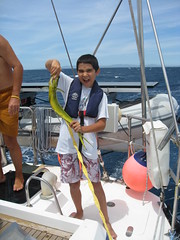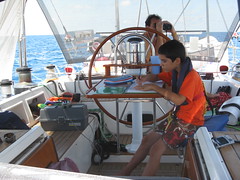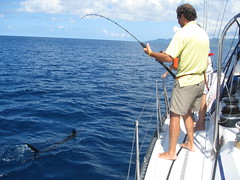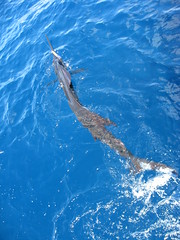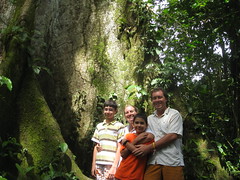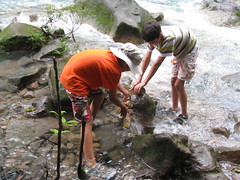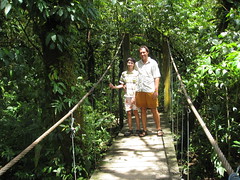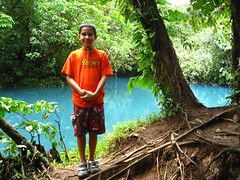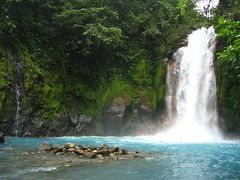We left Puntarenas in the early evening. Our departure was timed to coincide with the high tide, which is required for Samadhi to navigate in the shallow channel. Once we were outside of Puntarenas, we proceeded directly to the anchorage at Isla San Lucas where we would spend the night. We could have simply headed straight to Golfito that evening, but we decided it would be better to start our passage during daylight hours after a good night's sleep.
Arriving at Isla San Lucas we were greeted by steady 30 knot winds. We had anchored at San Lucas before and knew a good location with excellent holding for our anchor. We dropped the hook and settled in for the evening. Later the wind topped out in the 40 knot range as Samadhi strained at her anchor chain. The GPS showed that we weren't budging, so we set the anchor alarm and went to bed listening to wind singing in the rigging.
We woke up early in the morning, as the first signs of the sun were kissing the sky. The wind was still blowing, but it had moderated significantly and was now a tropical breeze instead of a gale. Within a few minutes we had the anchor up and fresh coffee was brewing as we headed out of the anchorage.
The wind continued to diminish as we crossed the Gulf of Nicoya. We tried sailing with different combinations of sails to try and get the most out of the wind. Unfortunately the wind continued to drop, and move around behind us. Now that we were running on a broad reach in light wind our boat speed dropped. So we decided to deploy our spinnaker to get our speed back up.
Getting the spinnaker up with just the two us takes about 15 minutes. We have to rig the sheets and tack line, as well as bring the spinnaker out of the sail locker. Once everything is set and double checked, we hoist the sail in a "sock" which keeps it contained until we are prepared to use it. As we prepared to take sail out of it's sock it was apparent the wind was starting to increase a bit... this seemed like a good thing at the time!
Kelly pulled the sock off the sail and I trimmed the sheet and tack. Within a moment we were rapidly accelerating under spinnaker! It's always a rush to see the sail inflate and snap into shape, while simultaneously feeling Samadhi picking up speed rapidly. We continued sailing happily along under spinnaker and main for about 30 minutes. Our boat speed was steadily increasing as the wind picked up.
Samadhi was sailing at 10 knots (without surfing!), and the spinnaker was starting to really load up. This seemed like a prudent time to douse the spinnaker and revert to our genoa and staysail. We eased Samadhi onto a dead run to get the Spinnaker blanketed by the mainsail. The spinnaker lost its wind as it moved behind the mainsail and collapsed. Kelly prepared to pull the sock over the sail before we drop it onto the deck. Suddenly the spinnaker partially inflated and wrapped itself around furled staysail, then it wrapped itself around the furled genoa! Soon we had 40' of free sail flapping wildly while the other 40' was wrapped around the two other headsails. Bad news!
I had made a mistake during the takedown of the sail: I hadn't tightened the sheet adequately after the spinnaker collapsed. This allowed it to move around and wrap itself around the other sails. Now we had a sail that we couldn't lower! We tried different combinations of pulling and twisting, nothing would free the sail. The wind was continuing to increase, and we were afraid that the spinnaker would damage itself from flogging. We reviewed our options and decided to point Samadhi back towards land, and try to get out of the wind by anchoring next to the cliffs.
At the same time we were determining what to do about the sail, once of the fishing reels started to sing. We were surprised to see a small Mahi Mahi on the end of the line, "surfing" behind the boat! Nicholas brought the fish in, and we immediately roughly prepped it and put it onto ice to deal with later. Nicholas was very proud of his first ever Mahi Mahi that he reeled in all by himself!
We turned the boat towards the nearest sheltered looking area, it was 5 miles away. This has to be one of the longest 5 mile stretches we have sailed, as we watched the spinnaker flogging back and forth the whole way there. All the while the wind continued to increase and shift in direction. Soon we were motoring almost dead upwind to reach our hope of shelter.
As we approached the cliffs two things became apparent: #1, the water was quite deep #2, it was still windy! We continued driving Samadhi closer to land, and the wind finally started to subside. We dropped the anchor worryingly close to the beach and set about trying to free the spinnaker. The wind was still coming in gusts, but there was a lull between each gust. Soon we had developed a system where we would pull a wrap off during a lull, then hold onto the sail as the gust came to avoid it from wrapping again. After some time we had freed the sail from all but the last two wraps. We now had a different problem, as when the gusts would come the sail would be pushed against the mast and spreaders which would hold it out, causing lots of strain on the anchor. Our tenuous anchorage was now a serious liability, as it was apparent that Samadhi was dragging her anchor in the gusts due to the sail.
Losing Samadhi on the beach was not an option. If we had to cut the spinnaker to shreds we would do it instead of lose the boat! With luck, there was a lull in the wind just long enough to unwrap the final turn and pull the sock down over the sail. Kelly dropped the sail to the deck while I dashed back to the cockpit to get the engine started and get us away from the beach!
I moved the boat away from the beach cautiously. Kelly brought the anchor in and we maneuvered the boat into deeper water, away from the surf. 10 minutes later we were headed safely away from the coast, and back on our way to Golfito. Only after all of the excitement was over did we see that nearly 3 hours had passed since we wrapped the spinnaker! To say that we will pay extra special attention to our spinnaker douses from here forward is an understatement...
We realized it was lunchtime. Luckily, we had the "Lunch Sized" mahi mahi! This fish was perfectly sized for 4 people. A big change from the last time we caught a mahi mahi, it was over 50lbs! Whatever bad feelings we had about messing up the spinnaker drop and the associated mess untangling it immediately disappeared as we dined like royalty on grilled filets. There is no finer cuisine than REALLY fresh seafood, and we are becoming spoiled eating it aboard Samadhi all of the time. :)
The wind was now dropping again, and soon we were forced to forego sailing as the wind was calm. Little did we know that was the last time we would see wind for the next 100 miles! The ocean smoothed out and turned glassy as we headed South towards Golfito. A spectacular sunset brought the first day to a close.
We motored through the night, in dead-calm conditions over a lake smooth ocean. During the night watches we tracked fishing boats on radar as we continued South.
Dawn arrived with a dull orange glow that grew until filled the entire sky. The return of the sun means putting the fishing lines back out again on Samadhi. There is nothing wrong with fishing at night, but dealing with a fish and maneuvering the boat in the dark is much less safe than during the day. The wind remained dead calm, and there wasn't a disturbance in the ocean aside from our hull cutting through the water, leaving a wake that seemed to stretch to infinity.
Fishing wasn't going that well, we landed and released a couple of bonito. We prefer fish that we like to eat! We were swapping lures to try and entice something else out of the ocean... preferably something that would taste good. Mid-morning one of our reels started screaming, this sound means that you have hooked something BIG. We got the boat stopped as the line kept pouring off the reel. We looked astern to see a billfish jumping out of the ocean repeatedly, then we knew what we were in for.
Kelly took care of the helm while I worked to get the fish in. Landing the fish was accomplished in a series of battles. First the fish would take a lot of line, then we would regain it (and a little more) then the fish would take more line... repeat this process for 30 minutes and suddenly the fish is alongside the boat!
We looked down into the ocean and saw a beautiful sailfish, shining in silver, blue and copper colors. Holding the fish alongside the boat, it measured 8' long. We decided that we would release the sailfish to keep the billfish fisheries populated. This was by far the largest fish we had ever caught while cruising! Everyone was happy to see the sailfish swim rapidly away after we cut the leader as close to the fish as we could. We later learned that sailfish are one of the fastest growing billfish, growing 5 feet in their first year. If we ever catch another sailfish and we have room in the freezer we are going to keep it and it eat it.
The wind didn't return, and continued into Golfito under power. Golfito is a very well protected natural harbor. You enter through a channel between a hill and a sandy spit of land and into a lovely framed by mountains. As we entered we saw a Dockwise yacht transport ship taking on two yachts, certainly an easy way to travel difficult passages.
We were greeted by Tim from Tierra Mar (Land Sea) who showed us to our mooring. Finally, we enjoyed a pizza dinner, celebrating our arrival in Golfito.
Thursday, March 5, 2009
Sunday, March 1, 2009
Hiking Rio Celeste
After a hard day's paddling in Caño Negro, we were only thinking of relaxing around the pool. Adri and Alex had other plans. They wanted to take us to hike up the side of a volcano and see the famous waterfall or catarata of the Rio Celeste in the Tenorio Volcano National Park. They even convinced Jonathan, Evelyn, and Ruth to join us! With the temptation of hot springs looming ahead, we eagerly packed up for another day in the great outdoors.
As usual in Costa Rica, finding our way to the trailhead was an adventure. Fernando and Alex stopped several times to ask directions from locals, and a good thing too! The recent heavy rains had washed out at least one of the roads. Undaunted, we made our way to the park. En route, we stopped to see the "Peace tree". We didn't have enough people to encircle it, so we had to make do with snapping photos in front.
Eventually, we arrived at the parking lot for the park. For some reason, it took a good solid half an hour to figure out where we were supposed to park and which trail to take. (Many of the trails were washed out.) We also put in our order for lunch at the soda with tilapia fresh from their pond. (Nicholas wanted to help catch them!) It would be ready for when we returned, about 2 o'clock.
From the start, the trail sloped steeply upward. We spent much of the time climbing stairs cut into the hillside. Nicholas and Alexander were fantastic and kept up better than some of the adults! In addition to the stairs there were many log bridges, some more than 100' long! After about 45 minutes of hiking, we arrived at the hot springs. Adri had advised us to wear our bathing suits so that we could partake. Unfortunately, because of the heavy rains, the river was swollen to the point of making the thermal pool only large enough for a small group, and there were already two soaking in it! While we waited for our turn, Alexander and Nicholas worked on building dams of their own by the banks.
Eventually, we were able to take a dip. It was amazing how quickly the temperatures changed. The hot water felt so nice and Nicholas even joined us. Alexander preferred to stay building his dams. We were eager to press on to be able to see all the sights, so we cut our soak short and headed back onto the trail towards the other attractions.
Rio Celeste is most famous for its milky aqua-blue water. It acquires the color suddenly when water heated by the volcano passes over a copper-rich rock and then meets a cold-water stream. We were mesmerized watching the transformation. Some of the pools are so blue that it looks unnatural. Not only that, but the water is crystal clear with a gravel bottom. Absolutely a stunning sight.
We also visited the "bubbling pool" of gaseous upwellings, the mirador, the suspension bridge, and the "blue lagoon" (no Brooke Shields in evidence though). Our favorite of all though was the catarata. (I love the Spanish word for "waterfall"!) We began by descending a precarious string of stairs set into the muddy soil of the volcano. Phil and the boys led the way. Their were lovely little flowers along the route and as we neared the pool, the roar of the waterfall became almost deafening.
We lingered for a moment, taking it all in. Then, Alex tells us that the trail leads across the river to the other side. Oh my! The current was very strong, but with all of us helping the boys made it across, no problem. In fact they did better than many of the adults who lost their footing on the slippery stones. The frigid water was a far cry from the thermal springs we'd enjoyed earlier, but it was exhilarating to have forded the stream. Now to get down the mountain to our lunch!
Lunch was absolutely delicious. The casados were exceptional, although whether from exertion or quality I couldn't say. For dessert they served us fresh local pineapple. Phil's a consummate pineapple snob, but the rest of us thought they were excellent. The presentation was beautiful too.
After cleaning all the mud off, we piled back into the cars and continued the trip to Puntarenas. The boys fell asleep almost instantly. We managed to make it all the way to the boat. What an amazing experience for our last weekend in Costa Rica before heading for Panama!
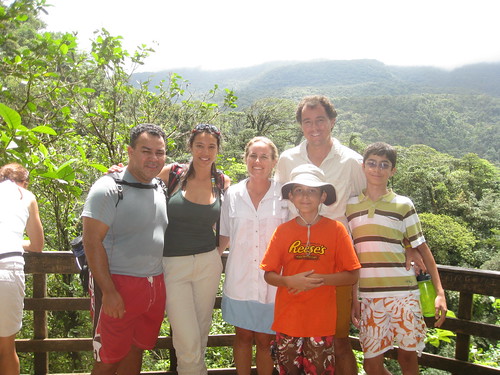
As usual in Costa Rica, finding our way to the trailhead was an adventure. Fernando and Alex stopped several times to ask directions from locals, and a good thing too! The recent heavy rains had washed out at least one of the roads. Undaunted, we made our way to the park. En route, we stopped to see the "Peace tree". We didn't have enough people to encircle it, so we had to make do with snapping photos in front.
Eventually, we arrived at the parking lot for the park. For some reason, it took a good solid half an hour to figure out where we were supposed to park and which trail to take. (Many of the trails were washed out.) We also put in our order for lunch at the soda with tilapia fresh from their pond. (Nicholas wanted to help catch them!) It would be ready for when we returned, about 2 o'clock.
From the start, the trail sloped steeply upward. We spent much of the time climbing stairs cut into the hillside. Nicholas and Alexander were fantastic and kept up better than some of the adults! In addition to the stairs there were many log bridges, some more than 100' long! After about 45 minutes of hiking, we arrived at the hot springs. Adri had advised us to wear our bathing suits so that we could partake. Unfortunately, because of the heavy rains, the river was swollen to the point of making the thermal pool only large enough for a small group, and there were already two soaking in it! While we waited for our turn, Alexander and Nicholas worked on building dams of their own by the banks.
Eventually, we were able to take a dip. It was amazing how quickly the temperatures changed. The hot water felt so nice and Nicholas even joined us. Alexander preferred to stay building his dams. We were eager to press on to be able to see all the sights, so we cut our soak short and headed back onto the trail towards the other attractions.
Rio Celeste is most famous for its milky aqua-blue water. It acquires the color suddenly when water heated by the volcano passes over a copper-rich rock and then meets a cold-water stream. We were mesmerized watching the transformation. Some of the pools are so blue that it looks unnatural. Not only that, but the water is crystal clear with a gravel bottom. Absolutely a stunning sight.
We also visited the "bubbling pool" of gaseous upwellings, the mirador, the suspension bridge, and the "blue lagoon" (no Brooke Shields in evidence though). Our favorite of all though was the catarata. (I love the Spanish word for "waterfall"!) We began by descending a precarious string of stairs set into the muddy soil of the volcano. Phil and the boys led the way. Their were lovely little flowers along the route and as we neared the pool, the roar of the waterfall became almost deafening.
We lingered for a moment, taking it all in. Then, Alex tells us that the trail leads across the river to the other side. Oh my! The current was very strong, but with all of us helping the boys made it across, no problem. In fact they did better than many of the adults who lost their footing on the slippery stones. The frigid water was a far cry from the thermal springs we'd enjoyed earlier, but it was exhilarating to have forded the stream. Now to get down the mountain to our lunch!
Lunch was absolutely delicious. The casados were exceptional, although whether from exertion or quality I couldn't say. For dessert they served us fresh local pineapple. Phil's a consummate pineapple snob, but the rest of us thought they were excellent. The presentation was beautiful too.
After cleaning all the mud off, we piled back into the cars and continued the trip to Puntarenas. The boys fell asleep almost instantly. We managed to make it all the way to the boat. What an amazing experience for our last weekend in Costa Rica before heading for Panama!

Subscribe to:
Posts (Atom)
